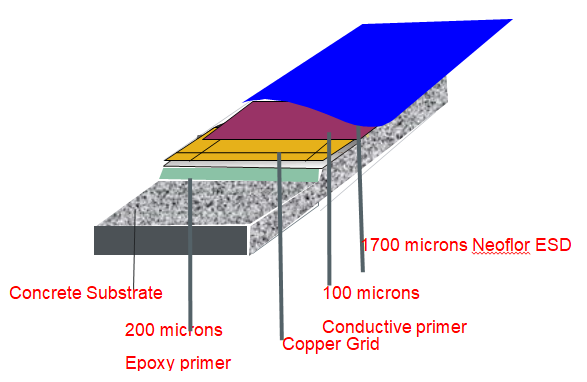Stamped concrete is concrete that is patterned and/or textured or embossed to resemble brick, slate, flagstone, stone, tile, wood, and various other patterns and textures. The ability of stamped concrete to resemble other building materials makes stamped concrete a less expensive alternative to using those other authentic materials such as stone, slate or brick.
There are three procedures used in stamped concrete which separate it from other concrete procedures; the addition of a base color, the addition of an accent color, and stamping a pattern into the concrete. These three procedures provide stamped concrete with a color and shape similar to the natural building material. It also is longer lasting than paved stone, and still resembles the look. Typically, stamped concrete is used as exterior flooring such as pathways, swimming pool decks, patios and sit-outs, porticos, pergolas, drive-ways and alike.
1. It is important that RCC slabs to not only provide proper slope and drainage,
but also to increase concrete cover (rather than trying to provide in the base-slab)
2. Protection of concrete and reinforcement from the ingress of water, CO2, chloride and other harmful gases
(if any) is imperative to prolong the life of the structure (especially the parking decks) by means of flexible coatings.
A look at the important characteristics of a protective coating of parking deck/Ramp reveals the following requirements:
- Load bearing capacity: The floor topping shall be capable of withstanding both the static and dynamic loads of passing vehicles as well as braking cars.
- Slip resistance: The floor topping shall provide the necessary friction with an anti-slip characteristics both in dry as well as wet condition. The possibility of car-tyres carrying mud and slush and causing abrasion and slip shall be considered.
- Oil and petrol resistance: The floor topping shall be resistant to the penetration of oil, gasoline, grease etc which are likely to fall off the parked vehicles.
- Aesthetics: The floor topping shall be of pleasing colours to provide a face-lift to the entire parking area. Additionally, it shall have all the line-markings for easy identification and navigation.
- Easy cleanability: The floor topping shall be easily cleanable and maintainable.
- As the movement of cars in and out of parking decks create a varying levels of bending moments in parking slabs. Hence the coatings shall be sufficiently flexible to withstand this movements.
- The floor topping is also expected to provide water-proofing, crack-bridging capability, as well as enable refurbishment.
Two important parameters need to be considered to select the correct product.
1. Why do you need the concrete to be resurfaced?
2. What is the extent of damage and what is the minimum thickness required?
Answer to the first question is whether
- To improve aesthetics and ambience
- To remove undulations in the concrete that is to receive carpet, vinyl, wooden or other polymeric flooring
- To overcome defects in existing concrete floor
- To enhance resistance to penetration of oil, grease, water, chemicals etc
- To reduce/eliminate dust generation
- To improve abrasion resistance
- To facilitate material movement and reduce maintenance cost
- To enhance safety to workmen
Answer to second question is whether thickness range is >50mm, 20-50mm, 10-20mm, 5-10mm, 2 -5mm, based on which correct product has to be selected
The only thing protecting reinforcing steel from rusting within concrete is the very high alkalinity of the concrete itself. Spalling is a process whereby atmospheric carbon dioxide neutralises the alkalinity of the concrete (a process termed “carbonation” (aka “alkali-aggregate reaction”), causing the steel reinforcement to rapidly corrode. Once the corrosion process commences, the corrosion products take up around eight times the volume that the original steel had, forcing the concrete around it to crack. As the corrosion progresses, the cracks widen, allowing moisture, oxygen and ions to enter and accelerate the corrosion problem.
Anti-carbonation coatings prevent the entry of CO2 into the concrete matrix thus retaining the alkalinity of concrete surrounding the rebar from decreasing, thus enhancing the longevity of the concrete.
Production of a quality concrete slab requires proper techniques and adequate planning. The following key areas have been identified as the most critical to achieving a satisfactory result of epoxy/PU toppings.
1. Subgrade
2. Damp-proof membrane (DPM) / Vapor Barrier/Vapor Retarders
3. Contraction (Control) Joint Location
4. Thickness and grade of concrete
5. Placing sequence
6. Controlling evaporation loss
7. Maintaining floor levelling
8. Correct surface finishing
9. Moisture content of cured floor
The main concept of anti-static flooring or ESD flooring (electro-static discharge) is that the static charge that accumulates in the body gets discharged immediately. Hence, the main constituents of an anti-static floor is copper tape conductor, a conductive primer and a conductive/dissipative epoxy topping
This can be pictorially depicted as follows:

Epoxy terrazzo has become exceedingly popular in because of its thin section, light weight, rich colors and resistance to cracking. Terrazzo has earned the reputation of being the floor best suited for heavy traffic areas due to its low maintenance and proven durability. (Expected life span of minimum 20 years). Thus it is being used both in India and abroad in museums, art galleries, airport passenger terminals, Malls and departmental stores, high-end residential bungalows, commercial complexes and condomoniums, 5-star hotel lobbies, kitchens and utility areas, automobile showrooms, pharmaceuticals, warehouses etc
